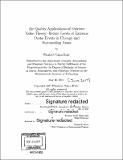Air quality applications of extreme value theory : return levels of extreme ozone events in Chicago and surrounding areas
Author(s)
Rider, Elizabeth Ndayu
DownloadFull printable version (2.610Mb)
Other Contributors
Massachusetts Institute of Technology. Department of Earth, Atmospheric, and Planetary Sciences.
Advisor
Noelle Eckley Selin.
Terms of use
Metadata
Show full item recordAbstract
To quantify the effects of the NO, SIP call in urban and rural locales, surface ozone data from the Air Quality System is analyzed. Methods from extreme value theory are applied to calculate and compare 20-year return levels at 5 urban and 17 rural/suburban sites in Illinois based upon maximum daily 8-. hour average ozone concentrations from summer (JJA) for two periods (1992- 2002 and 2003-2013) and a threshold of 70 (ppb). Between the two periods, 21 out of 22 sites experienced a decrease in 20-year return levels. The magnitude of these decreases does not indicate a strong correlation between population density and air quality improvements, however, further analysis is required.
Description
Thesis: S.B., Massachusetts Institute of Technology, Department of Earth, Atmospheric, and Planetary Sciences, 2017. Cataloged from PDF version of thesis. Includes bibliographical references (pages 21-24).
Date issued
2017Department
Massachusetts Institute of Technology. Department of Earth, Atmospheric, and Planetary SciencesPublisher
Massachusetts Institute of Technology
Keywords
Earth, Atmospheric, and Planetary Sciences.